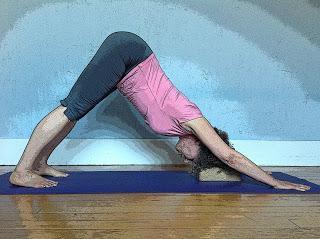
Photo by Erin Collom
Last week, my friend Erin Collom (thank you, Erin!), a Bay Area yoga teacher, took some photographs of me doing some of my favorite stress management and anti-anxiety poses. It was kind of nerve wracking for me because I’ve never been photographed doing yoga before (I’m typically somewhere behind the camera). But I decided we needed an older woman on the blog, and I was the handiest one around, so....When I saw this photograph of me doing Downward-Facing Dog, I was actually quite pleased. My alignment looks pretty good! Even my shoulders look good, which I wasn’t expecting. A well-balanced Downward-Facing Dog takes flexibility in both the legs (the hamstrings especially) and the shoulders. Back in the day, before I hit menopause, I had a lot of flexibility in both areas (some of it was natural and some of it was earned through consistent practice of the asanas over a period of years). But the hormonal changes brought on by perimenopause and menopause triggered a condition for me called a “frozen shoulder” that drastically limited my range of motion in my shoulder. A frozen shoulder is a condition where:
“Frozen shoulder (adhesive capsulitis) is stiffness, pain, and limited range of movement in your shoulder that may follow an injury. The tissues around the joint stiffen, scar tissue forms, and shoulder movements become difficult and painful. The condition usually comes on slowly, then goes away slowly over the course of several months or longer.” — from Web MD
The only quibble I have with that definition is that the “stiffness, pain, and limited range of motion” should be more like “extreme stiffness, constant pain, and drastically reduced range of motion”—yes, it’s that bad. After getting over the first one, which was on my left side, I managed to get one on the right side as well. But through both of those, as painful as it was, I continued to do non-weight bearing shoulder openers to try to prevent the permanent formation of scar tissue and gain back as much of my former range of motion as possible. (I also did strength building as well because the arm and shoulder muscles become withered as a result of the condition.) And after the condition had cleared up, I continued to work with these shoulder openers because I noticed I still did not have the range of motion I had originally and I could actually feel the presence of lingering scar tissue. While I was not necessarily expecting that I would regain what I had lost, I thought it worth trying, and besides, who doesn’t need to keep stretching our shoulders as we go through the aging process?
This photograph made me realize how much I had accomplished. So I thought I’d share my story in the hopes that it would inspire those of you who have or have had a frozen shoulder as well as anyone with tight shoulders who wants to make some changes.
Tomorrow Baxter will be presenting a sequence for tight shoulders. Some of these poses are ones that he teaches on a regular basis. But others are ones that I suggested to him because I had practiced them on a regular basis while my shoulder was “frozen” and painful as well as after the condition cleared up, always holding them for at least 90 seconds. These included the three different versions of hands up/on the wall and the doorknob version of Cobra. So if tight shoulders are a problem for you (see Friday Q&A: Tight Shoulders for information about why people have tights shoulders and how it can be a problem in both asanas and everyday life), maybe give these a try. I'm living proof that they actually do work!

